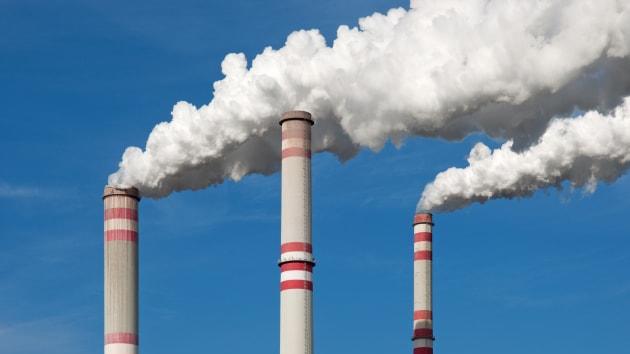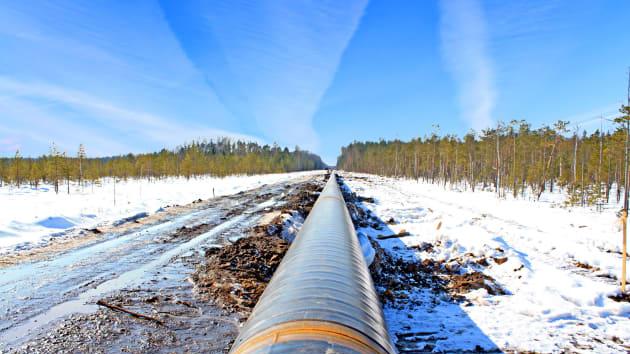methane
Latest

Pluto's moon Charon got its red toupée from the dwarf planet
NASA's New Horizons spacecraft showed us a part of Charon we'd never seen before: a rusty red section crowning its polar region. It's an intriguing feature, something the mission's ground team hadn't seen before, so they spent the past year studying all the data and images the probe sent back. Now, they have their answer. The red cap is apparently the product of methane gas escaping the dwarf planet itself and freezing solid in the frigid pole. Team leader Will Grundy, likens Pluto to a "graffiti artist, spray-painting its companion with a reddish stain that covers an area the size of New Mexico."

Sun-powered bacteria turn nasty CO2 into helpful biofuel
Cars emit polluting carbon dioxide (CO2) when they burn gas, but what if you could reverse the process? Scientists from the University of Washington have engineered a bacteria that can do just that: pull CO2 from the air and, using sunlight, convert it to methane and hydrogen gas. The organism only produces a limited amount of fuel, but the results could lead to ways to reduce CO2 in the air and produce useful fuel at the same time.

NASA's flying methane meter built for Mars finds work on Earth
Just as new military technologies often trickle down to civilian uses, a high-tech methane detector originally developed to detect gases on Mars has found a new role here on Earth. NASA's Jet Propulsion Lab built the the Open Path Laser Spectrometer (OPLS) and have affixed it to a standard quadcopter. And given that greenhouse gas emissions are currently at a 30-year high, according to the UN, this pipeline inspector can't come soon enough.

Modified rice plant produces more grain, less methane
Apparently, the secret to better, more eco-friendly rice plant is another type of grain: barley. A team of scientists has created genetically modified rice that borrows a single gene from barley and found that the altered organism can generate up to 43 percent more grains per plant. Plus, its methane emission is down to 0.3 percent, a lot lower than regular rice's 10 percent emission observed during the scientists' experiments. Methane, as you might know, is one of the most potent greenhouse gases and is the second most prevalent in the US after carbon dioxide.

Now there's a wearable for tracking your farts
Unless you're Le Pétomane, Terrence, Philip or Leslie Nielsen, you probably don't like the gaseous emissions that leak from your ass every now and again. Farts, you see, are a result of digestion, but unless you're paying attention to your diet, it's hard to work out what causes the most obnoxious of bum gases. That's where CH4 comes in, a wearable that sits in your back pocket or belt loop, keeping count of every air biscuit that you bake. Yes, ladies and gentlemen, we're now at the point where we need a crowdfunded gadget to warn us when we've let one rip.

India put a satellite in orbit around Mars for a fraction of what NASA spent
India can rightly feel proud of itself today as its Mangalyaan "MOM" satellite mission successfully entered orbit around Mars. In the process, the country has broken at least three records, including being the first Asian nation to reach the red planet and being the first country to get to Mars on the first attempt. Third on that list of achievements is that the project is one of the cheapest exploration projects in recent history, costing just $72 million -- pocket change compared to NASA's $670 million MAVEN probe and the $2 billion Curiosity Rover. India's Prime Minister, Narendra Modi, has even quipped that it cost less to launch the satellite than it cost to make the movie Gravity.

UN study shows atmospheric CO2 increases reach 30 year high
Aside from paying someone to scream "this is a problem" into everyone's faces, there's not much more that the UN can do to tell us that we're heading towards an environmental catastrophe. The United Nations' World Meteorological Organization has found more proof of our forthcoming doom, showing that atmospheric carbon dioxide levels rose faster between 2012-2013 than any other year since 1984. If the rate doesn't slow down, then the levels will reach 400 parts per million in the next two years - a figure well in excess of the 350ppm that most climate scientists believe is "safe."

Street View cars used to sniff out gas leaks, plots 'em on a map
Gas leaks are huge trouble. Leaky pipes are not only prone to exploding (which is already terrible, of course), they also spew out methane -- a greenhouse gas more potent than carbon dioxide in contributing to climate change. The bad news is, nobody's been monitoring gas leaks closely, so Google Earth Outreach and the Environmental Defense Fund teamed up to do the job back in July. Now, the results for the project's pilot tests are out, and they confirm what everyone suspects: old gas pipes do leak a lot more than new ones. In order to effectively survey large areas, the pair attached methane-detecting sensors to Google's famous roving vehicles: Street View cars. They then sent these dual-purpose vehicles to Boston, Indianapolis and Staten Island, whose results you can see in the images after the break.

Google Street View cars have mapped methane gas leaks in big US cities
Google's Street View cars aren't just useful for scouting out a locale in advance -- they might be saving the planet, too. The vehicles have just helped the Environmental Defense Fund publish methane gas leak maps for Boston, Indianapolis and New York City's Staten Island. The Google cars roamed around cities using sensors that could detect both the location and scale of one of the dangerous leaks, driving by at least twice to make sure the results weren't a fluke. Depending on where you live, the data is either reassuring or scary; the older pipes in Boston and Staten Island have an abundance of leaks, while Indianapolis' more recent infrastructure is keeping the problems to a minimum.

Life on Mars cast into doubt as Curiosity fails to find methane
[Click] Hi, is that David Bowie? [Silence] ... It's NASA here. We've got some news. While it's not a conclusive answer, the Curiosity Rover wasn't able to detect any traces of methane in the Gale Crater. Presence of the gas is one of the things that we were hoping would support our theories about life on Mars, so this comes as a bit of a blow. Now, there *are* terrestrial microbes that don't generate methane, so it's not as if this is a firm "no," but it's not looking anywhere near as likely as it was before. So, uh, does that help at all? [Silence] ... Uh, well, thanks. Bye! [Click]

Morpheus lander crashes, burns and explodes in untethered flight test, NASA remains optimistic (video)
As noisy as we found Project Morpheus' tethered flight test, its untethered follow-up was far, far louder. Yesterday, the experimental lander suffered a hardware component failure, which NASA says "prevented it from maintaining stable flight." This caused it to crash into the ground and well, explode. On the upside, the space agency says that these kinds of failures were anticipated, stating that they are a normal part of the development process and will be used to build better systems moving forward. You didn't think Curiosity made its touchdown on Mars without learning from a few mistakes, did you? Click onwards to check out the test -- and its aftermath -- in 5, 4, 3, 2, er...

NASA's Morpheus lander detects hazards, noisily passes tethered flight test (video)
While it's not landing on Mars any time soon, NASA took a breather from Curiosity's adventures to showcase the Morpheus Lander. The prototype went through its first (tethered) flight test at the Kennedy Space Center just before the weekend, showcasing its methane-powered rocket system. It's this rocket setup which could make the Morpheus Lander a strong candidate for future landings. It's both safer than rocket fuel and NASA suggests that methane gas discarded from the International Space Station could be enough to top up the lander's fuel tanks without necessitating a visit back to Earth. Morpheus' built-in guidance system also reduces the amount of input needed from mission control -- the pod has been practicing hard on its own hazard field near the Space Center. After passing the test with its training wheels on, the first free flight descent has been tentatively penned in for later today. Crank the volume low -- it gets loud -- and watch Morpheus test those right rockets after the break.

Scientists develop flush-efficient toilet system that can turn waste into energy, sort before it recycles
Scientists from Singapore's Nanyang Technological University aren't keen on being wasteful -- that's why they've developed a toilet that uses 90% less water than other commodes and is capable of generating energy. Aptly named the No-Mix Vacuum Toilet, the porcelain pedestal's pot divides waste between two partitions -- one side for liquids, the other for solids -- and uses vacuum tech reminiscent of airline lavatories. Flushing solid and fluid wastes with 1 and 0.2 liters of H2O, respectively, the can will be able to route refuse to external processing facilities. Fertilizer ingredients such as nitrogen, potassium and phosphorous would then be harvested from liquids. Similarly, methane can be coaxed from solids for conversion to electricity or as a replacement for other natural gasses. Two of the university's restrooms are slated to have the toilets installed in the near future, and the team expects the thrones to roll out worldwide within three years. [Thanks, Yuka]

New York City turns to sewers for energy solutions
Listen up New Yorkers, those hot nuts you just swallowed could be used to light the signs on Broadway. Okay, so that's a stretch, but the city's Department of Environmental Protection (DEP) just issued a plan to turn the stuff you flush, along with rest of its wastewater, into renewable energy. New York City produces about 1.3 billion gallons of wastewater daily, yielding 1,200 tons of biosolids that can be harvested to procure methane -- already accounting for 20 percent of the city's energy -- and butanol, a clean gasoline alternative. The plan, which also includes wind and solar projects, aims to use gas, converted by large digesters, to "power wastewater operations, meet on-site heat and electricity needs, and, where feasible, sell excess energy to the market." As the DEP points out, the plan isn't far fetched -- we've seen a couple of solutions for turning human excrement into usable energy, and a project already under way in Greenpoint is estimated to procure enough methane over the next year to heat 2,500 homes. Now, if that doesn't give you a newfound respect for the porcelain throne, we don't know what will.

Inhabitat's Week in Green: the dangers of LED lighting, self-healing nanotech, and spray-on solar power
Each week our friends at Inhabitat recap the week's most interesting green developments and clean tech news for us -- it's the Week in Green. This week Inhabitat shed light on the next generation of solar power as we showcased a spray-on film capable of generating 300% more energy than traditional photovoltaics and a new breed of nanotech cells that can heal themselves like plants. New biofuel projects also broke ground around the world as the US began construction on its first commercial biofuel plant and Canada upgraded a waste plant to be powered by soda and beer. And another farticle, er, article covers a project in Greenpoint, Brooklyn that takes the result of the results of those drinks (methane) and turns it into fuel. We also interviewed energy efficiency expert David Johnston, who shared 5 tips that could cut your electricity bill by up to 50 percent. And on a more sour energy efficiency note, we were appalled to see this new study that found that LEDs, like CFLs, also contain unsafe levels of carcinogenic toxins. The big (or should we say B.I.G) architecture news of the week was the unveiling of Bjarke Ingels Group's sloping residential pyramid for midtown Manhattan. In transportation news, Nissan revealed plans to roll out its Tesla-trouncing ESFLOW electric supercar at the Geneva Auto Show, while Chevrolet announced that the Volt will receive a $5,000 tax rebate in California. We also applauded the US government's $53 billion plan to jump start high speed rail, while republicans rallied against the movement towards more efficient infrastructure. We also showcased several stylish examples of wearable eco tech - a set of bio sensors that improve physical and emotional health, and a pair of GPS-enabled snow goggles that are perfect for shredding through uncharted territory. Finally, we shared 10 green iPad cases that are perfect for protecting your e-reader from blustery winter weather.

Volkswagen Beetle converted to run on methane headed for the UK streets
Meet the Bio-Bug, a custom modded Volkswagen Beetle which has been converted to run on biogas -- fuel created from human waste. The process of conversion isn't brand new, but this will be the first automobile fully converted to run on biogas in the United Kingdom without any loss of performance. In fact, the car is so reliable that its makers believe it can "blow away" electric vehicles, and that consumers won't even notice the difference. The Bio-Bug is a regular old 2 liter VW convertible modified to operate on both gasoline and compressed methane gas: once the methane runs out, the car reverts back to running on gasoline. The cars run on so little methane that just one regular sized sewage plant could run a car (or cars) over 95,000,000 miles per year. Developed by GENeco, a sustainable energy company in the UK, the Bio-Bug is going into a trial period, and the company plans on converting its entire fleet if successful.

Corncob waste could enable methane use in vehicles
Aside from the obvious choice, there's vehicles scooting around on bioethanol, batteries, fuel cells, and all sorts of other alternatives, but a recent breakthrough in Kansas City, Missouri has opened up the possibility of using natural gas. Currently, the cheaper and cleaner burning methane isn't feasible in modern vehicles due to the extremely high pressure (3,600 psi) and gargantuous tanks required to actually use it. Researchers at the University of Missouri-Columbia and Midwest Research Institute in Kansas City have devised a way to change all that, however, by using corncob waste to create "carbon briquettes with complex nanopores capable of storing natural gas at an unprecedented density of 180 times their own volume and at one seventh the pressure of conventional natural gas tanks." In layman's terms, this discovery allows natural gas to be held under much less pressure and in thin-walled tanks similar to cells used on current vehicles, which could instantly make natural gas a viable (and readily available) alternative fuel source. A prototype system has been working just fine since last October, and the backers are currently crafting a second revision in hopes of storing even more natural gas and driving production costs down, but there's still no hard deets on when this invention could see commercial light.[Via AutoblogGreen]

Fiat's tri-powered Multipla Multi-eco
Dual-powered cars aren't quite as unique as they used to be, but a vehicle that's able to run on three different power sources should be enough to perk up anyone's energy-saving, cost-cutting ears, even if just a little bit. At least that's what Fiat hopes will be your reaction to its latest concept car / tongue-twister, the Multipla Multi-eco. In addition to running on plain-old gasoline, it'll get you where you want to go on either methane or E85 bioethanol. The methane gets a fuel tank of its own, but the car's ECU is able to sort out the gas and bioethanol itself, letting you use any combination of them. This being a concept vehicle, however, you won't exactly be able to get behind the wheel of one anytime soon. However, Fiat is making a slight variation commercially available in the form of the Panda Panda, which lacks the E85 bioethanol option but still lets you run on your choice of methane or gasoline.[Via Autoblog]










